Invisible maelstrom: NASA flies spacecraft through magnetic explosions above Earth (VIDEO)

NASA has made its first ever observations from the heart of a ‘magnetic reconnection’ event thanks to its Magnetospheric Multiscale mission (MMS).
The mission, consisting of four identical spacecraft, was launched in March 2015 to observe these reactions in the magnetosphere – scientists had previously only witnessed reconnection in the laboratory.
The research, which was published in the journal Science, reveals that magnetic reconnection is dominated by the physics of electrons, bringing scientists closer to understanding the phenomenon.
So what exactly is magnetic reconnection and why is it important?
Magnetic reconnection occurs when magnetic fields collide and realign, sometimes causing powerful explosions throughout space. It converts magnetic energy into kinetic or thermal energy.
These explosions can put satellites, spacecraft and astronauts in space at risk. They can also have a major impact on Earth by causing solar flares and coronal mass ejections which can in turn activate geomagnetic storms that, if powerful enough, could disable our communications and electronics.
READ MORE: Scientists warn devastating solar storms could disable communications, electronics
Magnetic reconnection is one of the main drivers of space radiation and one of the key forces driving particles to accelerate through space.
On October 16 2015, MMS traveled straight through a magnetic reconnection event at the boundary where Earth’s magnetic field touches the sun’s magnetic field. It took only a few seconds for the 25 sensors on each spacecraft to collect thousands of observations.
"We received results faster than we could have expected. By seeing magnetic reconnection in action, we have observed one of the fundamental forces of nature," said Jim Burch, the principal investigator for MMS and lead author of the research.
"The decades-old mystery is what do the electrons do, and how do the two magnetic fields interconnect. Satellite measurements of electrons have been too slow by a factor of 100 to sample the magnetic reconnection region.
“The precision and speed of the MMS measurements, however, opened up a new window on the universe, a new 'microscope' to see reconnection." he continued.
A fundamental force
Reconnection is a force as fundamental in space as gravity is on Earth, according to NASA.
Mystery still surrounds why some magnetic connections are explosive while others are steady, either way the local particles involved are flung far away from one another, crossing magnetic boundaries they never could have crossed otherwise and releasing a huge amount of energy.
The MMS observations revealed that when two magnetic fields collide, electrons shoot away in straight lines from the original event at hundreds of miles per second, speeding across magnetic boundaries that would usually divert them.
Once they are across those boundaries, the particles begin to curve and make a U-turn, responding to the new magnetic fields they encounter.
These observations align with a computer simulation known as the ‘crescent model’. The persistent – and characteristic – crescent shape in the electron distributions suggests that the physics of electrons is at the heart of understanding how magnetic field lines accelerate particles.
READ MORE: NASA to invest in habitat & deep sleep chamber for Mars astronauts
"This shows us that the electrons move in such a way that electric fields are established and these electric fields in turn produce a flash conversion of magnetic energy,” said Roy Torbert, a co-author on the research paper.
“The encounter that our instruments were able to measure gave us a clearer view of an explosive reconnection energy release and the role played by electron physics."
The MMS has made more than 4,000 trips through the magnetic boundaries around Earth since its launch and has flown through a magnetic reconnection event five more times.
Scientists say this information and ongoing research is crucial at a time when space exploration is becoming more reliant on satellites and astronauts prepare to journey to Mars.












